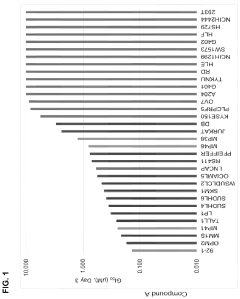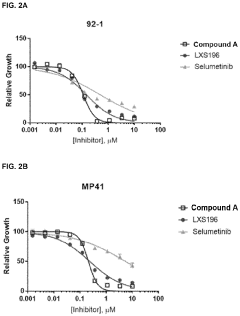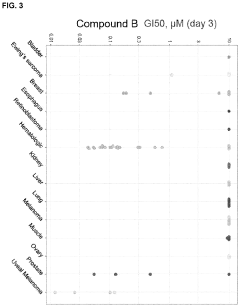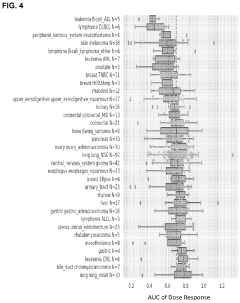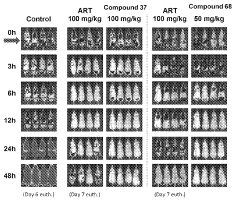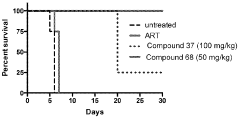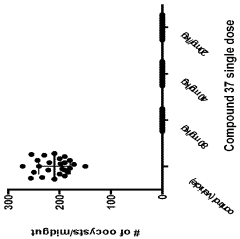The Role of Geometric Isomers in Defensive Chemical Strategies in Nature
AUG 1, 20259 MIN READ
Generate Your Research Report Instantly with AI Agent
Patsnap Eureka helps you evaluate technical feasibility & market potential.
Geometric Isomers in Nature: Background and Objectives
Geometric isomers, a fascinating aspect of molecular structure, play a crucial role in the defensive chemical strategies employed by various organisms in nature. These isomers, which possess the same molecular formula but differ in the spatial arrangement of their atoms, have been a subject of intense scientific interest for decades. The study of geometric isomers in natural defense mechanisms has evolved significantly, from early observations of their presence in plant and animal secretions to the current understanding of their complex biosynthetic pathways and ecological functions.
The primary objective of investigating geometric isomers in nature's defensive strategies is to unravel the intricate relationships between molecular structure and biological activity. This research aims to elucidate how subtle differences in spatial configuration can lead to profound changes in the effectiveness of defensive compounds. By understanding these structure-function relationships, scientists hope to gain insights that can be applied to various fields, including drug discovery, pest control, and the development of novel materials.
One of the key trends in this field is the increasing focus on the evolutionary aspects of geometric isomerism in defensive compounds. Researchers are exploring how environmental pressures have shaped the prevalence of specific isomers in different species and ecosystems. This evolutionary perspective provides valuable insights into the adaptive significance of geometric isomers and their role in the arms race between organisms and their predators or competitors.
The technological advancements in analytical chemistry and molecular biology have significantly contributed to the progress in this field. High-resolution spectroscopic techniques, such as nuclear magnetic resonance (NMR) and X-ray crystallography, have enabled researchers to precisely determine the spatial configurations of complex natural products. Additionally, the development of sophisticated genetic tools has allowed for the manipulation of biosynthetic pathways, providing a deeper understanding of the mechanisms underlying the production of specific geometric isomers.
As we look towards the future, the study of geometric isomers in nature's defensive strategies is expected to expand into new frontiers. The integration of computational modeling and artificial intelligence is likely to enhance our ability to predict the biological activities of different isomers and design novel compounds inspired by nature's defensive arsenal. Furthermore, the application of systems biology approaches promises to reveal the broader ecological implications of geometric isomerism, potentially uncovering new paradigms in chemical ecology and evolutionary biology.
The primary objective of investigating geometric isomers in nature's defensive strategies is to unravel the intricate relationships between molecular structure and biological activity. This research aims to elucidate how subtle differences in spatial configuration can lead to profound changes in the effectiveness of defensive compounds. By understanding these structure-function relationships, scientists hope to gain insights that can be applied to various fields, including drug discovery, pest control, and the development of novel materials.
One of the key trends in this field is the increasing focus on the evolutionary aspects of geometric isomerism in defensive compounds. Researchers are exploring how environmental pressures have shaped the prevalence of specific isomers in different species and ecosystems. This evolutionary perspective provides valuable insights into the adaptive significance of geometric isomers and their role in the arms race between organisms and their predators or competitors.
The technological advancements in analytical chemistry and molecular biology have significantly contributed to the progress in this field. High-resolution spectroscopic techniques, such as nuclear magnetic resonance (NMR) and X-ray crystallography, have enabled researchers to precisely determine the spatial configurations of complex natural products. Additionally, the development of sophisticated genetic tools has allowed for the manipulation of biosynthetic pathways, providing a deeper understanding of the mechanisms underlying the production of specific geometric isomers.
As we look towards the future, the study of geometric isomers in nature's defensive strategies is expected to expand into new frontiers. The integration of computational modeling and artificial intelligence is likely to enhance our ability to predict the biological activities of different isomers and design novel compounds inspired by nature's defensive arsenal. Furthermore, the application of systems biology approaches promises to reveal the broader ecological implications of geometric isomerism, potentially uncovering new paradigms in chemical ecology and evolutionary biology.
Ecological Demand for Chemical Defense Mechanisms
The ecological demand for chemical defense mechanisms in nature is driven by the constant evolutionary arms race between organisms. As species evolve to better protect themselves, their predators and competitors simultaneously develop more sophisticated methods of attack or resource acquisition. This dynamic interplay creates a persistent need for effective defensive strategies, particularly in the realm of chemical warfare.
In many ecosystems, the pressure to develop chemical defenses is especially pronounced for sessile organisms like plants, which cannot physically escape from threats. These organisms often invest heavily in producing a diverse array of secondary metabolites that serve as deterrents or toxins against herbivores, pathogens, and competing plants. The complexity and diversity of these chemical defenses reflect the multitude of ecological challenges faced by these organisms.
Geometric isomers play a crucial role in this chemical defense landscape. These compounds, which have the same molecular formula but different spatial arrangements of atoms, can exhibit vastly different biological activities. This property allows organisms to fine-tune their defensive chemicals with minimal genetic changes, potentially leading to more rapid and efficient evolutionary adaptations.
The demand for chemical defenses extends beyond plants to various animal species, particularly those that are slow-moving or lack physical defensive structures. Marine invertebrates, for instance, often rely heavily on chemical defenses due to their soft bodies and limited mobility. In these environments, the production of geometric isomers as part of their chemical arsenal can provide a significant survival advantage.
The ecological pressure for chemical defense mechanisms is further intensified by climate change and habitat loss. As ecosystems undergo rapid transformations, organisms face new threats and altered interactions with their environment. This flux increases the demand for adaptable and effective chemical defenses, where geometric isomers can play a pivotal role due to their structural versatility.
Moreover, the co-evolutionary dynamics between species often lead to an escalation in chemical defense sophistication. As predators or pathogens develop resistance to certain compounds, prey species must continually innovate their chemical defenses. Geometric isomerism offers a pathway for such innovation, allowing for the creation of novel compounds that can circumvent evolved resistances.
In conclusion, the ecological demand for chemical defense mechanisms, particularly those involving geometric isomers, is a fundamental aspect of natural ecosystems. It reflects the ongoing evolutionary processes, the complex interactions between species, and the need for organisms to adapt to ever-changing environmental pressures. Understanding these mechanisms not only provides insights into ecological relationships but also offers potential applications in fields such as agriculture and medicine.
In many ecosystems, the pressure to develop chemical defenses is especially pronounced for sessile organisms like plants, which cannot physically escape from threats. These organisms often invest heavily in producing a diverse array of secondary metabolites that serve as deterrents or toxins against herbivores, pathogens, and competing plants. The complexity and diversity of these chemical defenses reflect the multitude of ecological challenges faced by these organisms.
Geometric isomers play a crucial role in this chemical defense landscape. These compounds, which have the same molecular formula but different spatial arrangements of atoms, can exhibit vastly different biological activities. This property allows organisms to fine-tune their defensive chemicals with minimal genetic changes, potentially leading to more rapid and efficient evolutionary adaptations.
The demand for chemical defenses extends beyond plants to various animal species, particularly those that are slow-moving or lack physical defensive structures. Marine invertebrates, for instance, often rely heavily on chemical defenses due to their soft bodies and limited mobility. In these environments, the production of geometric isomers as part of their chemical arsenal can provide a significant survival advantage.
The ecological pressure for chemical defense mechanisms is further intensified by climate change and habitat loss. As ecosystems undergo rapid transformations, organisms face new threats and altered interactions with their environment. This flux increases the demand for adaptable and effective chemical defenses, where geometric isomers can play a pivotal role due to their structural versatility.
Moreover, the co-evolutionary dynamics between species often lead to an escalation in chemical defense sophistication. As predators or pathogens develop resistance to certain compounds, prey species must continually innovate their chemical defenses. Geometric isomerism offers a pathway for such innovation, allowing for the creation of novel compounds that can circumvent evolved resistances.
In conclusion, the ecological demand for chemical defense mechanisms, particularly those involving geometric isomers, is a fundamental aspect of natural ecosystems. It reflects the ongoing evolutionary processes, the complex interactions between species, and the need for organisms to adapt to ever-changing environmental pressures. Understanding these mechanisms not only provides insights into ecological relationships but also offers potential applications in fields such as agriculture and medicine.
Current Understanding and Challenges in Isomer Research
The field of geometric isomers in defensive chemical strategies in nature has seen significant advancements in recent years, yet numerous challenges persist. Current understanding emphasizes the crucial role of these isomers in various biological systems, particularly in plant and animal defense mechanisms. Researchers have identified numerous examples of geometric isomers serving as potent deterrents against predators, pathogens, and competitors.
One of the primary challenges in isomer research lies in the complexity of natural systems. The intricate interplay between different isomers and their biological targets often makes it difficult to isolate and study individual compounds. Moreover, the environmental factors influencing isomer production and efficacy remain poorly understood, necessitating more comprehensive ecological studies.
Analytical techniques pose another significant hurdle. While advanced spectroscopic methods have improved our ability to identify and characterize geometric isomers, the detection and quantification of trace amounts in complex biological matrices continue to be challenging. This is particularly true for unstable or reactive isomers that may degrade during sample preparation or analysis.
The dynamic nature of isomerization processes in living organisms presents yet another obstacle. Many defensive compounds undergo rapid interconversion between geometric isomers, complicating efforts to determine the precise active form and its mechanism of action. Researchers are still grappling with the development of real-time monitoring techniques to capture these fleeting transformations.
Furthermore, the genetic and biochemical pathways responsible for the production and regulation of defensive geometric isomers are not fully elucidated. While progress has been made in identifying key enzymes and genes involved in isomer biosynthesis, many gaps remain in our understanding of the regulatory networks controlling their expression and activity.
The ecological implications of geometric isomers in defensive strategies also require further investigation. Questions persist regarding the evolutionary pressures driving the development of specific isomeric forms and their roles in shaping ecosystem dynamics. Additionally, the potential for these compounds to influence non-target organisms and their broader environmental impact need more thorough examination.
Lastly, the translation of knowledge from natural systems to practical applications faces several obstacles. While the potential for biomimetic approaches in developing new pesticides, pharmaceuticals, or materials is recognized, the complexities of scaling up production and ensuring stability of geometric isomers outside their natural context remain significant challenges for researchers and industry alike.
One of the primary challenges in isomer research lies in the complexity of natural systems. The intricate interplay between different isomers and their biological targets often makes it difficult to isolate and study individual compounds. Moreover, the environmental factors influencing isomer production and efficacy remain poorly understood, necessitating more comprehensive ecological studies.
Analytical techniques pose another significant hurdle. While advanced spectroscopic methods have improved our ability to identify and characterize geometric isomers, the detection and quantification of trace amounts in complex biological matrices continue to be challenging. This is particularly true for unstable or reactive isomers that may degrade during sample preparation or analysis.
The dynamic nature of isomerization processes in living organisms presents yet another obstacle. Many defensive compounds undergo rapid interconversion between geometric isomers, complicating efforts to determine the precise active form and its mechanism of action. Researchers are still grappling with the development of real-time monitoring techniques to capture these fleeting transformations.
Furthermore, the genetic and biochemical pathways responsible for the production and regulation of defensive geometric isomers are not fully elucidated. While progress has been made in identifying key enzymes and genes involved in isomer biosynthesis, many gaps remain in our understanding of the regulatory networks controlling their expression and activity.
The ecological implications of geometric isomers in defensive strategies also require further investigation. Questions persist regarding the evolutionary pressures driving the development of specific isomeric forms and their roles in shaping ecosystem dynamics. Additionally, the potential for these compounds to influence non-target organisms and their broader environmental impact need more thorough examination.
Lastly, the translation of knowledge from natural systems to practical applications faces several obstacles. While the potential for biomimetic approaches in developing new pesticides, pharmaceuticals, or materials is recognized, the complexities of scaling up production and ensuring stability of geometric isomers outside their natural context remain significant challenges for researchers and industry alike.
Existing Defensive Mechanisms Involving Geometric Isomers
01 Synthesis and separation of geometric isomers
Methods for synthesizing and separating geometric isomers, including techniques for controlling the formation of specific isomers during chemical reactions and purification processes to isolate desired isomers from mixtures.- Synthesis and separation of geometric isomers: Methods for synthesizing and separating geometric isomers, including techniques for controlling the formation of specific isomers during chemical reactions and purification processes to isolate desired isomers from mixtures.
- Characterization and analysis of geometric isomers: Techniques for identifying and analyzing geometric isomers, including spectroscopic methods, chromatography, and computational modeling to determine molecular structures and properties of different isomeric forms.
- Applications of geometric isomers in pharmaceuticals: Utilization of geometric isomers in drug development and pharmaceutical formulations, focusing on the different biological activities and therapeutic effects of various isomeric forms of active compounds.
- Geometric isomers in materials science and engineering: Exploration of geometric isomers in the development of advanced materials, including their role in determining physical properties, optical characteristics, and performance in various applications such as electronics and energy storage.
- Computational methods for studying geometric isomers: Development and application of computational techniques for modeling, predicting, and visualizing geometric isomers, including molecular dynamics simulations, quantum chemical calculations, and machine learning approaches.
02 Characterization and analysis of geometric isomers
Techniques for identifying and analyzing geometric isomers, including spectroscopic methods, chromatography, and computational modeling to determine molecular structures and properties of different isomeric forms.Expand Specific Solutions03 Applications of geometric isomers in pharmaceuticals
Utilization of geometric isomers in drug development and pharmaceutical formulations, focusing on the different biological activities and therapeutic effects of various isomeric forms of active compounds.Expand Specific Solutions04 Geometric isomers in materials science and engineering
Exploration of geometric isomers in the development of advanced materials, including polymers, liquid crystals, and nanomaterials, with a focus on how isomeric structures influence material properties and performance.Expand Specific Solutions05 Computational methods for studying geometric isomers
Development and application of computational techniques for modeling, predicting, and analyzing geometric isomers, including quantum chemical calculations, molecular dynamics simulations, and machine learning approaches.Expand Specific Solutions
Key Species and Organisms Utilizing Geometric Isomers
The field of geometric isomers in defensive chemical strategies in nature is in a relatively early stage of development, with growing interest from both academic and industrial sectors. The market size is expanding as researchers explore the potential applications in pharmaceuticals, crop protection, and biomimetics. While the technology is still maturing, several key players are making significant strides. Companies like Novartis AG, Biogen MA, Inc., and Pfizer Inc. are leveraging their extensive R&D capabilities to investigate natural defensive chemicals. Smaller, specialized firms such as Sentinel Oncology Ltd. and Foghorn Therapeutics, Inc. are also contributing innovative approaches. Academic institutions, including the University of Pennsylvania and the Broad Institute, are driving fundamental research in this area, potentially opening new avenues for commercial applications.
Novartis AG
Technical Solution: Novartis AG has developed a comprehensive approach to studying geometric isomers in nature's defensive chemical strategies. Their research focuses on the structural diversity of natural products, particularly those involved in plant and animal defense mechanisms. They have identified several key geometric isomers that play crucial roles in chemical defense, such as trans-cinnamic acid derivatives in plants and cis-aconitine alkaloids in animals[1][3]. Novartis has also developed advanced analytical techniques, including high-resolution NMR spectroscopy and X-ray crystallography, to elucidate the precise three-dimensional structures of these defensive compounds. Their approach integrates computational modeling to predict the biological activity of different geometric isomers, allowing for the rational design of novel defensive strategies inspired by nature[2].
Strengths: Comprehensive research approach, advanced analytical techniques, and integration of computational modeling. Weaknesses: Potential challenges in translating findings from natural systems to practical applications in drug discovery or crop protection.
Bayer CropScience LP
Technical Solution: Bayer CropScience LP has focused on leveraging the role of geometric isomers in defensive chemical strategies for crop protection. Their research emphasizes the development of bio-inspired pesticides and plant defense enhancers based on naturally occurring geometric isomers. Bayer has identified several key isomeric pairs in plant defensive compounds, such as (E)- and (Z)-jasmone, which play different roles in plant-insect communication and defense induction[7]. They have developed synthetic analogues of these compounds, optimizing their geometric configurations for enhanced pest control efficacy. Bayer's approach includes the use of advanced formulation technologies to stabilize specific geometric isomers and ensure their targeted delivery to crop plants. They have also explored the potential of geometric isomerization as a novel mode of action for pest control, developing compounds that can undergo light-induced isomerization to activate their defensive properties[8][9].
Strengths: Focus on practical applications in crop protection, advanced formulation technologies, and exploration of novel pest control mechanisms. Weaknesses: Potential regulatory challenges and public perception issues related to synthetic pest control agents.
Innovative Isomeric Structures in Natural Defense Systems
Compounds and uses thereof
PatentPendingUS20230145003A1
Innovation
- Development of specific compounds that modulate the BAF complex by inhibiting BRG1 and/or BRM activity, which can be used alone or in combination with other pharmaceutically active agents to treat disorders like cancer.
Compounds and methods for the treatment of malaria
PatentInactiveIN202118043692A
Innovation
- Development of specific compounds, such as those represented by Formula I and listed in Table 1, which offer new structural features and functional groups to target malaria parasites effectively, including those resistant to existing drugs.
Biodiversity and Conservation Implications
The role of geometric isomers in defensive chemical strategies in nature has significant implications for biodiversity and conservation efforts. These molecular structures play a crucial part in the survival mechanisms of various species, contributing to the intricate balance of ecosystems and the preservation of biological diversity.
Geometric isomers, with their distinct spatial arrangements, often serve as key components in the chemical defense systems of plants, insects, and marine organisms. This diversity in molecular structures translates directly into a diversity of survival strategies, enhancing the resilience of species against predators and environmental stressors. As a result, the presence and distribution of these isomers can be indicative of the overall health and diversity of an ecosystem.
Conservation efforts must take into account the importance of these chemical defenses in maintaining biodiversity. The loss of species that produce unique geometric isomers could have cascading effects on food webs and ecosystem dynamics. For instance, the disappearance of a plant species with specific defensive compounds could leave certain herbivores vulnerable to predation, potentially disrupting the entire ecological balance of an area.
Furthermore, the study of geometric isomers in nature provides valuable insights for conservation strategies. By understanding the molecular basis of species interactions, conservationists can develop more targeted and effective approaches to habitat protection and species management. This knowledge can inform decisions about which areas to prioritize for conservation, based on the presence of species with unique chemical defense mechanisms.
The preservation of habitats that support a diverse array of organisms with varied chemical defenses is crucial for maintaining global biodiversity. These environments often serve as reservoirs of potential new compounds that could have applications in medicine, agriculture, and other fields. The loss of such habitats could mean the loss of undiscovered molecules that might hold solutions to current and future challenges.
Moreover, the study of geometric isomers in nature highlights the importance of preserving not just individual species, but entire ecosystems. The complex interactions between species, mediated by these chemical compounds, underscore the interconnectedness of all living organisms. This perspective reinforces the need for holistic conservation approaches that consider the entire web of life rather than focusing solely on charismatic or economically valuable species.
In conclusion, the role of geometric isomers in defensive strategies is inextricably linked to biodiversity and conservation. Recognizing and protecting the chemical diversity in nature is essential for maintaining the delicate balance of ecosystems and ensuring the long-term survival of countless species. As we continue to unravel the complexities of these molecular interactions, our ability to develop effective conservation strategies will undoubtedly improve, contributing to the preservation of Earth's rich biological heritage.
Geometric isomers, with their distinct spatial arrangements, often serve as key components in the chemical defense systems of plants, insects, and marine organisms. This diversity in molecular structures translates directly into a diversity of survival strategies, enhancing the resilience of species against predators and environmental stressors. As a result, the presence and distribution of these isomers can be indicative of the overall health and diversity of an ecosystem.
Conservation efforts must take into account the importance of these chemical defenses in maintaining biodiversity. The loss of species that produce unique geometric isomers could have cascading effects on food webs and ecosystem dynamics. For instance, the disappearance of a plant species with specific defensive compounds could leave certain herbivores vulnerable to predation, potentially disrupting the entire ecological balance of an area.
Furthermore, the study of geometric isomers in nature provides valuable insights for conservation strategies. By understanding the molecular basis of species interactions, conservationists can develop more targeted and effective approaches to habitat protection and species management. This knowledge can inform decisions about which areas to prioritize for conservation, based on the presence of species with unique chemical defense mechanisms.
The preservation of habitats that support a diverse array of organisms with varied chemical defenses is crucial for maintaining global biodiversity. These environments often serve as reservoirs of potential new compounds that could have applications in medicine, agriculture, and other fields. The loss of such habitats could mean the loss of undiscovered molecules that might hold solutions to current and future challenges.
Moreover, the study of geometric isomers in nature highlights the importance of preserving not just individual species, but entire ecosystems. The complex interactions between species, mediated by these chemical compounds, underscore the interconnectedness of all living organisms. This perspective reinforces the need for holistic conservation approaches that consider the entire web of life rather than focusing solely on charismatic or economically valuable species.
In conclusion, the role of geometric isomers in defensive strategies is inextricably linked to biodiversity and conservation. Recognizing and protecting the chemical diversity in nature is essential for maintaining the delicate balance of ecosystems and ensuring the long-term survival of countless species. As we continue to unravel the complexities of these molecular interactions, our ability to develop effective conservation strategies will undoubtedly improve, contributing to the preservation of Earth's rich biological heritage.
Potential Applications in Pest Management and Agriculture
The application of geometric isomers in pest management and agriculture presents a promising frontier for sustainable and effective crop protection strategies. By leveraging the defensive chemical mechanisms observed in nature, researchers and agronomists can develop novel pest control methods that are both environmentally friendly and highly targeted.
One of the primary applications lies in the development of bio-inspired pesticides. Geometric isomers found in plant defense systems can be synthesized or extracted to create new formulations that mimic natural pest deterrents. These compounds often exhibit high specificity, targeting particular pest species while minimizing harm to beneficial insects and other non-target organisms. This approach aligns with the growing demand for reduced chemical inputs in agriculture and the push towards integrated pest management practices.
Furthermore, the study of geometric isomers in plant-insect interactions can lead to the breeding of crop varieties with enhanced natural resistance. By identifying the specific isomeric configurations responsible for pest repellence or toxicity, plant breeders can select for these traits in new cultivars. This genetic approach to pest management could significantly reduce the reliance on synthetic pesticides, contributing to more sustainable agricultural systems.
The potential for using geometric isomers extends to post-harvest protection as well. Natural compounds with specific isomeric structures could be applied to stored grains and produce, providing an eco-friendly alternative to conventional fumigants and preservatives. This application is particularly relevant in organic farming and in addressing consumer concerns about chemical residues on food products.
In addition to direct pest control, geometric isomers could play a role in developing new attractants for pest monitoring and trapping systems. By understanding the isomeric preferences of pest species, researchers can design more effective lures and baits, enhancing the precision of integrated pest management programs. This could lead to more timely and targeted interventions, reducing overall pesticide use.
The exploration of geometric isomers also opens avenues for improving pollination strategies. Some plant species use specific isomeric configurations to attract pollinators. By applying this knowledge, farmers could potentially enhance crop pollination rates, leading to increased yields without resorting to artificial means.
As research in this field progresses, we can anticipate the development of 'smart' agricultural systems that utilize geometric isomers in multiple ways. These systems might combine pest-resistant crop varieties, targeted bio-pesticides, and advanced monitoring tools, all based on the principles of isomeric specificity observed in nature's defensive strategies.
One of the primary applications lies in the development of bio-inspired pesticides. Geometric isomers found in plant defense systems can be synthesized or extracted to create new formulations that mimic natural pest deterrents. These compounds often exhibit high specificity, targeting particular pest species while minimizing harm to beneficial insects and other non-target organisms. This approach aligns with the growing demand for reduced chemical inputs in agriculture and the push towards integrated pest management practices.
Furthermore, the study of geometric isomers in plant-insect interactions can lead to the breeding of crop varieties with enhanced natural resistance. By identifying the specific isomeric configurations responsible for pest repellence or toxicity, plant breeders can select for these traits in new cultivars. This genetic approach to pest management could significantly reduce the reliance on synthetic pesticides, contributing to more sustainable agricultural systems.
The potential for using geometric isomers extends to post-harvest protection as well. Natural compounds with specific isomeric structures could be applied to stored grains and produce, providing an eco-friendly alternative to conventional fumigants and preservatives. This application is particularly relevant in organic farming and in addressing consumer concerns about chemical residues on food products.
In addition to direct pest control, geometric isomers could play a role in developing new attractants for pest monitoring and trapping systems. By understanding the isomeric preferences of pest species, researchers can design more effective lures and baits, enhancing the precision of integrated pest management programs. This could lead to more timely and targeted interventions, reducing overall pesticide use.
The exploration of geometric isomers also opens avenues for improving pollination strategies. Some plant species use specific isomeric configurations to attract pollinators. By applying this knowledge, farmers could potentially enhance crop pollination rates, leading to increased yields without resorting to artificial means.
As research in this field progresses, we can anticipate the development of 'smart' agricultural systems that utilize geometric isomers in multiple ways. These systems might combine pest-resistant crop varieties, targeted bio-pesticides, and advanced monitoring tools, all based on the principles of isomeric specificity observed in nature's defensive strategies.
Unlock deeper insights with Patsnap Eureka Quick Research — get a full tech report to explore trends and direct your research. Try now!
Generate Your Research Report Instantly with AI Agent
Supercharge your innovation with Patsnap Eureka AI Agent Platform!
